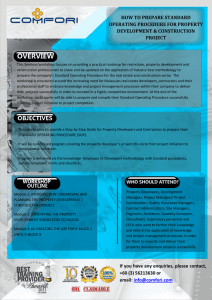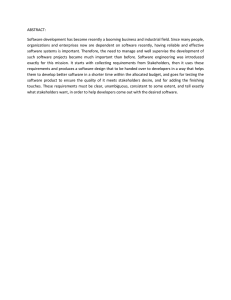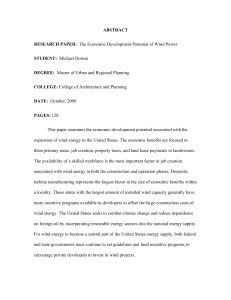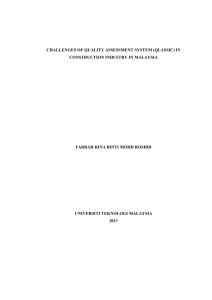ii iii iv
advertisement
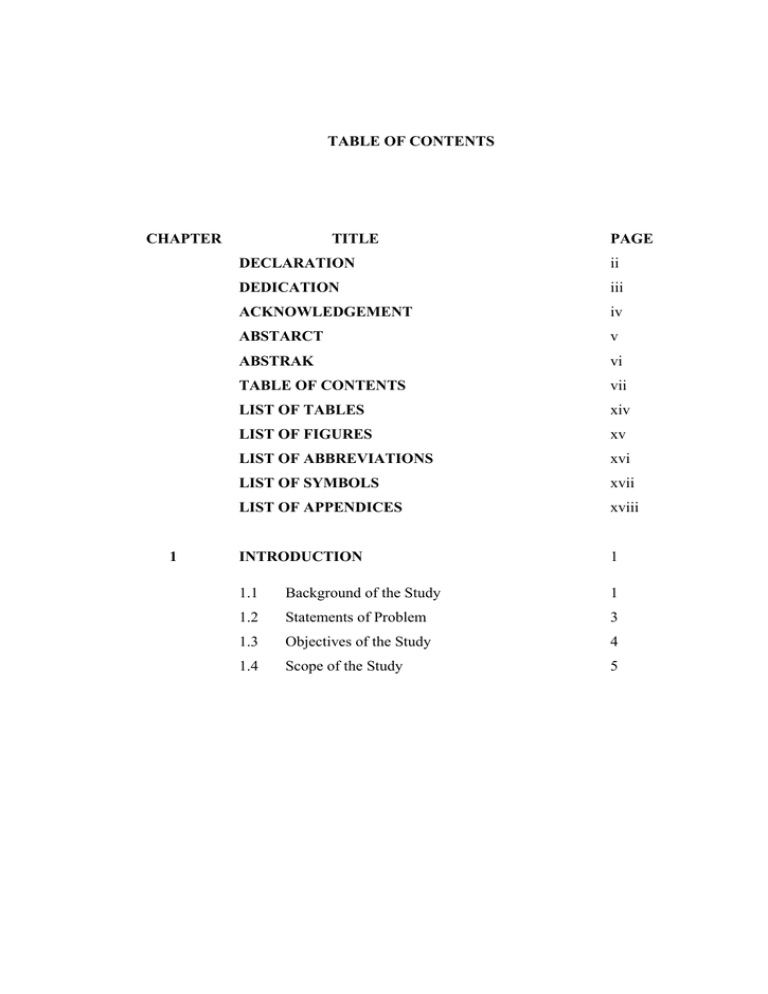
TABLE OF CONTENTS CHAPTER 1 TITLE PAGE DECLARATION ii DEDICATION iii ACKNOWLEDGEMENT iv ABSTARCT v ABSTRAK vi TABLE OF CONTENTS vii LIST OF TABLES xiv LIST OF FIGURES xv LIST OF ABBREVIATIONS xvi LIST OF SYMBOLS xvii LIST OF APPENDICES xviii INTRODUCTION 1 1.1 Background of the Study 1 1.2 Statements of Problem 3 1.3 Objectives of the Study 4 1.4 Scope of the Study 5 2 LITERATURE REVIEW 6 2.1 Quality Definition 6 2.1.1 7 2.2 2.3 2.4 2.5 Principles of Total Quality 9 2.2.1 Customer Focus 9 2.2.2 Process orientation 10 2.2.3 Continuous improvement and learning 10 2.2.4 Empowerment and Teamwork 11 2.2.5 Management by fact 11 2.2.6 Leadership and strategic Planning 13 TQ and Traditional Management Practices 13 2.3.1 Strategic Planning and Management 13 2.3.2 Changing Relationship with Customers and Suppliers 14 2.3.3 Organizational Structure 14 2.3.4 Organizational Change 15 2.3.5 Teamwork 15 2.3.6 Motivation and Job Design 15 2.3.7 Management and Leadership 16 Quality Management System 16 2.4.1 Aids to Promoting Quality Management 16 2.4.2 Barriers to Quality 17 2.4.3 Top Management’s Reluctance to Commit 18 Theory by Philip B.Crosby’s Definition of Quality 18 2.5.1 Five Absolutes of Quality Management 18 2.5.2 Crosby’s Perspective on Quality 19 2.5.3 Philips Crosby’s Fourteen-Step Quality 2.5.4 2.6 The Concept of Quality Programme 20 Successes and Failures 21 QLASSIC Introduction 22 2.6.1 QLASSIC Definition 23 2.6.2 Objective of QLASSIC 24 2.6.3 Scope of QLASSIC 24 2.6.4 QLASSIC Assessors 2.6.5 Assessment Approach and Sampling Process 2.6.6 25 25 Construction Industry Standard (CIS 7:2006) on Quality Assessment System for Building Construction Work 26 2.6.7 QLASSIC Assessment Process Flow 30 2.6.8 Importance and Advantages on application for QLASSIC assessment 2.6.9 Basic Tools and Equipment used in Assessment 3 32 RESEARCH METHODLOGY 34 3.1 Introduction 34 3.1.1 Defining the Research Objectives 35 3.1.2 Defining the Target Population 35 3.1.3 Defining the Mode of Administration 35 3.1.4 Developing Questionnaire 36 3.1.5 Designing the Sampling Approach 37 3.2 3.3 4 32 Data Analysis 37 3.2.1 Collecting and Processing the Data 38 3.2.2 Estimation and Data Analysis 39 Schematic of Research Methodology 40 DATA ANALYSIS 42 4.1 Introduction 42 4.2 Questionnaire Sample Distribution 42 4.3 Questionnaire Design 44 4.3.1 44 Section A : Respondent’s Profile and Background 4.3.2 Section B : Advantages in Application of QLASSIC System 4.3.3 Section C : Barriers in Application of 45 QLASSIC System 4.3.4 Section D : Strategy for Barrier Breaker and Its Improvement 4.4 Data Analysis 4.4.1 46 47 47 Section A : Analysis on Respondent’s Profile and Background using Frequency Analysis 4.4.1.1 Questionnaire Feedback 4.4.1.2 Experience in Construction Industry 52 4.4.1.3 Contractor Grade 53 4.4.1.4 Public and Private Projects 54 4.4.1.5 Knowledge on QLASSIC 56 4.4.1.6 Application in QLASSIC 57 4.4.1.7 Building Category 59 4.4.1.8 Involvement of Technical 4.4.1.9 4.4.2 50 Personnel In QLASSIC 61 Project Location 62 Section B : Analysis on Advantages in Application of QLASSIC System using Average Index Analysis 4.4.2.1 Analysis in Developers Companies 4.4.2.2 63 Analysis in Contractors Companies 4.4.3 63 66 Section C : Analysis on Barriers in Application of QLASSIC System using Average Index Analysis 4.4.3.1 Analysis in Developers Companies 4.4.3.2 69 Analysis in Contractors 69 Companies 4.4.4 72 Section D : Analysis on Strategy for Barrier Breaker and Improvement in Application of QLASSIC System using Average Index Analysis 4.4.4.1 Analysis in Developers Companies 4.4.4.2 Analysis in Contractors Companies 5 75 78 CONCLUSION AND RECOMMENDATION 82 5.1 Introduction 82 5.2 Achievement of the Study 82 5.2.1 Objective 1 : To identify the driving factors to the application of QLASSIC 5.2.2 Objective 2 : To identify the barriers in comply with QLASSIC 5.2.3 82 84 Objective 3 : To establish the improvement and strategy of barrier breaker towards QLASSIC application 85 5.3 Conclusion 86 5.4 Recommendation 88 References 89 Appendices 91 LIST OF TABLES TABLE NO. 2.1 TITLE PAGE Allocation of Weightage according to Component and Building category 29 4.1 Likert Scale for Section B 45 4.2 Likert Scale for Section C 46 4.3 Likert Scale for Section D 47 4.4 Average Index rating scale 48 4.5 Average Index rating scale 49 4.6 Average Index rating scale 50 4.7 Respondent’s Feedback 51 4.8 Advantages in Application of QLASSIC System for Developers Companies 4.9 Advantages in Application of QLASSIC System for Contractors Companies 4.10 72-73 Strategy for Barrier Breaker and its improvement for Developers Companies 4.13 69-70 Barriers in Application of QLASSIC System for Contractors Companies 4.12 66-67 Barriers in Application of QLASSIC System for Developers Companies 4.11 63-64 75-77 Strategy for Barrier Breaker and its improvement for Contractors Companies 78-80 LIST OF FIGURES FIGURE NO. TITLE PAGE 2.1 The Quality Concept 8 2.2 Philip Crosby’s triangle of interactions 21 2.3 Assessments Process flow 31 2.4 Spirit Level (1.2m length) 33 2.5 Tapping Rod 33 2.6 L-Square (24’’x12’’) 33 3.1 Schematic of Research Methodology 40 4.1 Number of Respondents 51 4.2 Respondents feedback 52 4.3 The Numbers of Year in Construction Industry 53 4.4 Contractor Grade 54 4.5 Types and No. of Projects Involved 55 4.6 Knowledge on QLASSIC 56 4.7 No. of Years Applied QLASSIC 58 4.8 No. of Project That Assess by QLASSIC 59 4.9 Categories of Project Involved 60 4.10 Technical Personnel Involved in QLASSIC 61 4.11 Project Location that Involved QLASSIC 62 LIST OF ABREVIATIONS TC - Technical Committee CIS - Construction Industry Standard CIDB - Construction Industry Development Board PWD - Public Works Department JPN - Jabatan Perumahan Negara REDHA - Real Estate and Housing Developers Association Malaysia PAM - Pertubuhan Arkitek Malaysia MBAM - Master Builiders Association Malaysia HBA - National House Buyers Association QLASSIC - Quality Assessment System TQ - Total Quality CONQUAS - Construction Quality Assessment System QA/QC - Quality Assurance/Quality Check CIMP - Construction Industry Malaysia Plan DPM - Deputy Prime Minister ST - Seven Strategic Thrust M&E - Mechanical and Electrical CPC - Certificate of Practical Completion GFA - Gross Floor Area ACMV - Air-conditioning and Mechanical Ventilation LIST OF SYMBOLS Σ - Sum α - Alpha ≤ - Less or similar LIST OF APPENDICES APPENDIX I TITLE Questionnaire Survey PAGE 91
